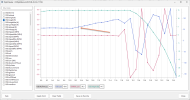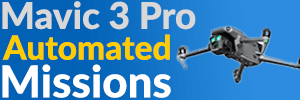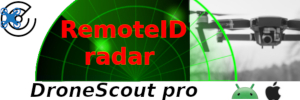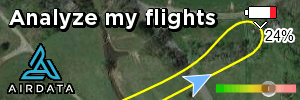Good evening. Attached is a flight log from my Mini 3 Pro, which crashed. I was hoping someone could provide an analysis of what happened. Thank you!
You are using an out of date browser. It may not display this or other websites correctly.
You should upgrade or use an alternative browser.
You should upgrade or use an alternative browser.
What Happened / Crash Analysis
- Thread starter MikeinMO
- Start date
It's always easier with a short description of what happened or what you observed.
But here's what I make from the data.
It looks like you launched (without waiting for GPS or to have the drone record a home point) and climbed to about 15 feet and started to fly backwards.
As you started to fly backwards, it looks like the drone started to run away from you, accelerating and quickly crashed.
It might have curved off to one side, but I can't tell much because you didn't have good GPS location data.
What can you tell about the spot where you powered up and launched?
Perhaps it was a reinforced concrete surface?
What direction was the drone pointing at launch time?
I can see that you had a yaw error which was caused by powering up somewhere with magnetic interference.
before launching and until the drone reached 15 feet, the compass indicates that the drone was pointing northeast at 56°.
Although you never used the rudder to rotate the drone, the compass heading started changing and swung to 94° (east) before the drone crashed at 11.9 seconds.
BTW .. although you should have waited for GPS reception and home point recording before launching, that didn't cause the incident.
This crash would have happened with or without waiting for GPS.
But here's what I make from the data.
It looks like you launched (without waiting for GPS or to have the drone record a home point) and climbed to about 15 feet and started to fly backwards.
As you started to fly backwards, it looks like the drone started to run away from you, accelerating and quickly crashed.
It might have curved off to one side, but I can't tell much because you didn't have good GPS location data.
What can you tell about the spot where you powered up and launched?
Perhaps it was a reinforced concrete surface?
What direction was the drone pointing at launch time?
I can see that you had a yaw error which was caused by powering up somewhere with magnetic interference.
before launching and until the drone reached 15 feet, the compass indicates that the drone was pointing northeast at 56°.
Although you never used the rudder to rotate the drone, the compass heading started changing and swung to 94° (east) before the drone crashed at 11.9 seconds.
BTW .. although you should have waited for GPS reception and home point recording before launching, that didn't cause the incident.
This crash would have happened with or without waiting for GPS.
Thank you sir. I was looking for a review of the data and didn't want to potentially bias anyone with what I think happened. Essentially, one of our pilots crashed the Mini 3, and the explanation was somewhat cryptic as to what happened. The location where the pilot took off was at a gas station. The pilot launched between the gas pumps with an overhead awning and the building, next to his vehicle. He pulled up between the pumps and building, set the drone outside his vehicle, and took off. I attached the screen shot from AirData. That hopefully gives some context to the site.It's always easier with a short description of what happened or what you observed.
But here's what I make from the data.
It looks like you launched (without waiting for GPS or to have the drone record a home point) and climbed to about 15 feet and started to fly backwards.
As you started to fly backwards, it looks like the drone started to run away from you, accelerating and quickly crashed.
It might have curved off to one side, but I can't tell much because you didn't have good GPS location data.
What can you tell about the spot where you powered up and launched?
Perhaps it was a reinforced concrete surface?
What direction was the drone pointing at launch time?
I can see that you had a yaw error which was caused by powering up somewhere with magnetic interference.
before launching and until the drone reached 15 feet, the compass indicates that the drone was pointing northeast at 56°.
Although you never used the rudder to rotate the drone, the compass heading started changing and swung to 94° (east) before the drone crashed at 11.9 seconds.
BTW .. although you should have waited for GPS reception and home point recording before launching, that didn't cause the incident.
This crash would have happened with or without waiting for GPS.
I put the data into the Phantom site. I noticed that almost immediately after powering on the drone, the pilot launched with no GPS fix and without an established home point. The pilot look the drone up to about 14-15 feet, and then went backwards.
I think the pilot climbed to the 15 feet with the intent of clearing the awning over the gas pumps, stated to maneuver backwards to get to the subject property for the photos, but backed into the awning, around 15 feet high. The collision then caused the motor errors, and the drone fell end-over-end to the ground. I think the compass changes, etc that you're referring to are when the drone was falling to the ground. I think the motor errors happened when the rear motors (one or both) collided with (because he was going backwards) the awing (those motors stopped), the front ones kept spinning, and the drone flipped over end-over-end, and tumbled 15 feet to the ground.
Thank you for the review and assistance!
-Mike
Attachments
That sounds like it could have been a reinforced concrete surface?where the pilot took off was at a gas station. The pilot launched between the gas pumps with an overhead awning and the building, next to his vehicle. He pulled up between the pumps and building, set the drone outside his vehicle
... which could be the source of the magnetic interference.
The first indications of the collision are in the pitch, roll and yaw data from 11.9 seconds.I think the compass changes, etc that you're referring to are when the drone was falling to the ground.
But the compass starts to swing at 10.3 seconds and the heading steadily increases from 56° to 94° until the collision.
Thank you. Would you contribute the crash to a combination of pilot error and interference issues?That sounds like it could have been a reinforced concrete surface?
... which could be the source of the magnetic interference.
The first indications of the collision are in the pitch, roll and yaw data from 11.9 seconds.
But the compass starts to swing at 10.3 seconds and the heading steadily increases from 56° to 94° until the collision.
It would appear to me that this crash was 100% avoidable. The pilot took off with no home point, no GPS fix, and at a location (concrete, metal awning and building) which would have allowed for interference. In addition, the pilot didn’t have good situational awareness flying from inside the truck and not visually observing the takeoff. Would those compass errors display a compass error? I didn’t see that in the Phantom or AirData results.
- Joined
- Oct 12, 2016
- Messages
- 30,353
- Reactions
- 34,292
- Location
- Harrisburg, PA (US)
- Site
- mavichelp.com
You can see where that started to occur here in Flight Reader:I didn’t see that in the Phantom or AirData results

Agreed. Once the drone was in the air, the crash was likely unavoidable given the confined flying area. The pilot's confusing story was probably due to the magnetic interference, which is known to cause drones to follow unintended flight paths.It would appear to me that this crash was 100% avoidable. The pilot took off with no home point, no GPS fix, and at a location (concrete, metal awning and building) which would have allowed for interference
Just a side note about a possible yaw error due to a power on in magnetic interference that deflects the compass during the IMU initialization...
The consequence of a yaw error (mainly a flyaway) will only happen if the drone have a proper GPS lock & tries to hold position against outside forces (wind)... & there do it with the wrong motors due to a false initialization of the IMU heading.
In this case a sufficient GPS position wasn't established yet, at 8,5sec the gpsLevel went from 0 to 2 but dropped down to a 1 during the crash... this means that the drone didn't have the ability to hold position yet.
So even though the drone possibly had a yaw error, it was very likely not the cause as the drone crashed before a proper GPS lock.
The consequence of a yaw error (mainly a flyaway) will only happen if the drone have a proper GPS lock & tries to hold position against outside forces (wind)... & there do it with the wrong motors due to a false initialization of the IMU heading.
In this case a sufficient GPS position wasn't established yet, at 8,5sec the gpsLevel went from 0 to 2 but dropped down to a 1 during the crash... this means that the drone didn't have the ability to hold position yet.
So even though the drone possibly had a yaw error, it was very likely not the cause as the drone crashed before a proper GPS lock.
Looks like the takeoff location was a setup for failure, vehicles, pumps, concrete, overhead awning...Yikes. Add in a pilot in a hurry and you've got the makings of an instructional video "recipe for disaster" "how to lose/crash your drone in seconds". Sadly, it's bound to be repeated.
Hi~Thank you. Would you contribute the crash to a combination of pilot error and interference issues?
It would appear to me that this crash was 100% avoidable. The pilot took off with no home point, no GPS fix, and at a location (concrete, metal awning and building) which would have allowed for interference. In addition, the pilot didn’t have good situational awareness flying from inside the truck and not visually observing the takeoff. Would those compass errors display a compass error? I didn’t see that in the Phantom or AirData results.
Pilot error? yes and no....
Yes:
the pilot took off his drone with several high risk element: gas station (I assume with cars and flammable fuel there), no GPS when take off, narrow initial airspace to confirm the status of the drone....
Yet, this are just risk factors. He can fly 100 times safe.... but the problem is, with these conditions, he would not be able to mitigate or take remedial action when **** happens.
No:
With a narrow interpretation, there was nothing possible to be done by the pilot in that moment and location....1 sec isn't enough for the pilot to aware the problem and took action accordingly. Besides, there were no options for him at all.....
Anyway, I suppose most authority across the world would place the responsibility to the pilot until proven that no reasonable steps can be foreseen and taken. (very unlikely in this case, given the limited known facts)
So, i think it is always important to find a suitable take-off point where you can have good views and sufficient airspace for you to take-off, do a bit of flight-control test (just move the sticks to different directions to see if the drone response as expected), and more importantly, if it doesn't you have decent chance to immediately land it without hurting anyone/anything/ the drone itself.
Further checks (battery status, magnetic condition and wind condition etc) should also be done depends on the nature of the flight. Yet, the control test seems to be the easiest one but most effective one.
Similar threads
- Replies
- 20
- Views
- 3K
- Replies
- 5
- Views
- 612
- Replies
- 28
- Views
- 5K
DJI Drone Deals
New Threads
-
3 firework show in Poland from Jan 1st 2026
- Started by marcinzmyslowski
- Replies: 0
-
What's the absolute worst drone you've ever flown?😖
- Started by Daniel NZDF
- Replies: 4
-
Mini 4 Pro A couple of Fire Towers in South East Queensland Australia
- Started by Geofff
- Replies: 0
-
-
POLICE DRONE PROGRAMS HIT 6,000 NATIONWIDE AS LEGAL CHALLENGES MOUNT
- Started by mavic3usa
- Replies: 3










